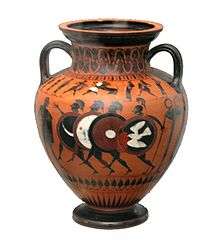Aspis

An aspis (Ancient Greek: ἀσπίς, plural aspides, ἀσπίδες), sometimes also referred to as a hoplon, was the heavy wooden shield used by the infantry in various periods of ancient Greece. [1]
Construction
An aspis was deeply dished and made primarily of wood. Some had a thin sheet of bronze on the outer face, often just around the rim. In some periods, the convention was to decorate the shield; in others, it was usually left plain. Probably the most famous aspis decoration is that of Sparta (Lacedaemon): a capital lambda (Λ), for Lacedaemon (Λακεδαίμων). From the late 5th century BCE, Athenian hoplites commonly used the little owl, while the shields of Theban hoplites were sometimes decorated with a sphinx, or the club of Heracles.
The aspis measured at least 0.91 metres (3 ft 0 in) in diameter and weighed about 7.3 kilograms (16 lb), and it was about 25–38 millimetres (0.98–1.50 in) thick.[2] This large shield was made possible partly by its shape, which allowed it to be supported on the shoulder. The revolutionary part of the shield was, in fact, the grip. Known as an Argive grip, it placed the handle at the edge of the shield, and was supported by a leather fastening (for the forearm) at the centre. This allowed hoplites more mobility with the shield, as well as the ability to capitalize on their offensive capabilities and better support the phalanx. The shield rested on a man's shoulders, stretching down the knees. These large shields were designed for a mass of hoplites to push forward into the opposing army, a move called othismos, and it was their most essential equipment.[3] That the shield was also made of wood[4] made it possible for warriors to use it as a floatation device for crossing rivers, and its large, round shape allowed it to be used for hauling the bodies of the dead from the battlefield.
Such shields did not tend to survive the passage of time very well, and only one aspis has survived into modernity with sufficient preservation to allow us to determine the details of its construction: this shield is called the "Bomarzo" or "Vatican" shield, and it is currently located in the Vatican, within the Museo Gregoriano Etrusco. It was discovered in 1830 near Bomarzo in Lazio, central Italy.[5]
See also
References
- ↑ Fred Eugene Ray, Jr. (11 August 2011). Land Battles in 5th Century BC Greece: A History and Analysis of 173 Engagements. McFarland. p. 9. ISBN 978-0-7864-5260-6.
The word hoplon sometimes denoted this piece of equipment, but that word found use most often in the plural (hopla) to describe all the tools of war (i.e., arms, with hoplites signifying a man at arms).
- ↑ Zimmel, Girard, Jonathan, Todd. "Hoplites Arms and Armor". Retrieved 9 September 2014.
- ↑ Sage, Michael M (1996). Warfare in Ancient Greece: A Sourcebook. London, GBR: Routledge. p. 281.
- ↑ Piotr Grotowski (24 September 2010). Arms and Armour of the Warrior Saints: Tradition and Innovation in Byzantine Iconography (843–1261). BRILL. p. 215. ISBN 90-04-18548-8.
- ↑ John and Hilary Travis (3 July 2014). Roman Shields. Amberley Publishing Limited. p. 33. ISBN 978-1-4456-3843-0.